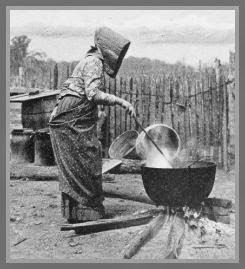Enter now to win a copy of
How the West Was Worn: Bustles and Buckskins on the Wild Frontier

Everyday wear for women throughout the early West generally consisted of cotton, wool, or linen dresses or skirts protected by an apron. Skirts of the 1850s were simply large pieces of fabric cut into rectangles. Some had inseam pockets, while some had openings in the seams with separate pockets underneath. Workaday skirts and dresses were usually absent of any trim around the hem. If a woman insisted on wearing a hoop with her skirt or dress, the length of the garment measured at least 4 feet wider than the hoop. Dressy skirts, including those worn for dancing, were 2 inches from the ground. Skirts for working could be as high as 6 inches.
Most clothing for miners and their families was homemade. Women sewed endlessly, making and mending garments for themselves and for all the members of their family. The clothing they made reflected the conditions of climate, weather, and income. Woven fabrics were available at general stores and many women purchased what they could afford. Otherwise, they spun or wove most of the material needed for the clothes. The fabric was then dyed using plant leaves, stems and blossoms of wood and meadow flowers, roots, bark, nut-hulls, tree galls, berries, and fruit pits and skins. Sewing patterns you could purchase were unheard of until the late 1880s; instead, clothes were cut from homemade patterns, and occasionally, old garments were disassembled and used as patterns.
Women married to prospectors lucky enough to hit the mother lode dressed in more ornate styles, but like those struggling to make ends meet, still took into account how to keep clothes clean. Caring for clothing, regardless of whether the item was homemade or store-bought, required work and time. In 1867, a two-piece dress of white cotton with a printed background became popular due to its easy care and was sold in stores, then duplicated by seamstresses throughout the West. The garment was known as the “wash dress” because it could be laundered easily. Women from all socioeconomic backgrounds wore “wash dresses.”

How the West Was Worn 2
I'm looking forward to hearing from you! Please fill out this form and I will get in touch with you if you are the winner.
Join my email news list to enter the giveaway.
"*" indicates required fields
How the West Was Worn 2
I'm looking forward to hearing from you! Please fill out this form and I will get in touch with you if you are the winner.
Join my email news list to enter the giveaway.
"*" indicates required fields
To learn more about the sometimes bizarre, often beautiful, and highly inventive clothing of the Old West read How the West Was Worn: Bustles and Buckskins on the Wild Frontier.




